Swansea's deflated 1802 record hot air balloon flight attempt
- Published

Early attempts at hot air balloon flights were unpredictable and potentially dangerous
With a cat and a dog as passengers, 20,000 people watched as the first hot air balloon was launched in Wales.
But the balloon, made of tissue paper, was engulfed by fire on lift-off from Swansea in October 1802.
It was one of numerous attempts by travelling showman Francis Barratt to become the first in Wales to fly a hot air balloon.
But many of his efforts to soar above Wales ended in deflation.
The first attempt in 1802 came 19 years after the world's first manned balloon flight soared into the air from Chateau de la Muette in Paris.
Historian Rosemary Chaloner said the failure to launch the balloon in Swansea was not unexpected given Mr Barratt's previous efforts.
"Mr Barratt had already achieved a measure of notoriety when on 13 August 1802, after an unsuccessful attempted ascent from Greenwich, he had to release an unmanned balloon to save it from rioting spectators," she said.
"His woven fabric balloon hadn't arrived in Swansea by early October, so he was forced to entertain the crowds with a demonstration of a tissue paper balloon measuring 18m in diameter, under which he slung a cat and small dog in a cage."
High wind and a jammed release line resulted in the balloon being destroyed by fire on lift-off.
Local reports are conspicuously muted as to the fate of the passengers.
Hot air balloons fascinated people throughout the 19th century, according to historian Rosemary Chaloner
Humans have long been fascinated with taking to the skies, and continue to be mesmerised by flight.
"Until the advent of aeroplanes in the early twentieth century, balloons were the only means man had ever had of leaving the ground," Ms Chaloner said.
'Del Boy character'
Not deterred, a few days later Mr Barratt was successful, when two smaller unmanned balloons, made of "common printing paper", remained aloft for nearly 10 minutes, rising more than 1,000 feet and covering a distance of 200 yards.
Eventually, his full-sized balloon arrived, and it was displayed in the ballroom of the George Hotel, raising the £70 Mr Barratt required for the flight.
But he was again beset by misfortune.
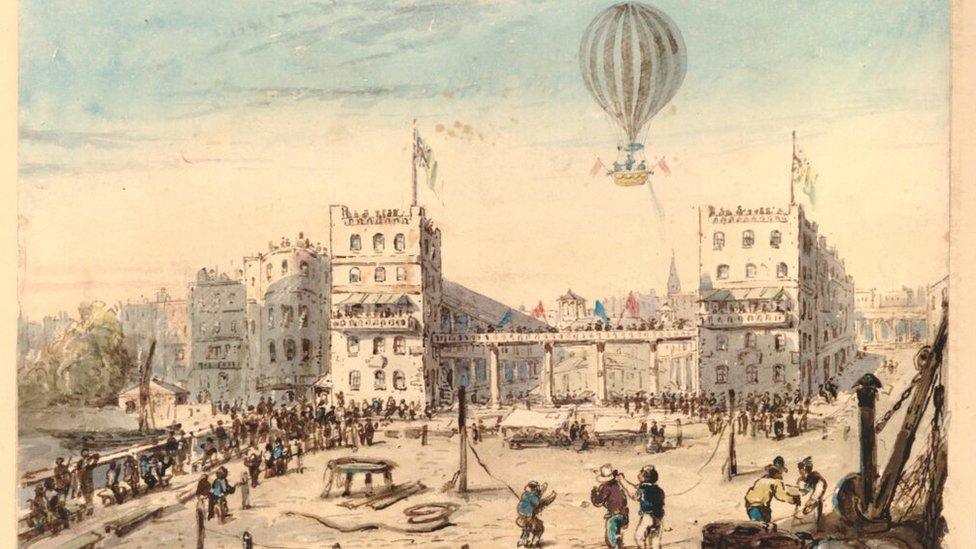
"Mr Barratt was something of a Del Boy character. You can almost hear him saying to his assistants, his wife and son: 'Rodney, what a plonker!'," said Ms Chaloner said, who became fascinated with balloon flight while researching her book 'The Balloon Girl'.
Early in the morning of 6 October 1802, the balloon was erected on a stage and while it inflated, The Times reported, "the fields, hills, houses, the ships in the harbour, were all crowded with people from most distant parts of the country."
But the balloon failed to inflate, and while the expectant crowd waited, the stage collapsed, damaging the balloon and breaking a young boy's leg.
A fair chunk of Mr Barratt's crowdfunding went on the surgeon's bill to reset the boy's leg, so when the flight was rescheduled for 15 October he was more desperate than ever.
"The hydrogen for the lift-off was provided by pouring sulphuric acid onto barrels of iron filings beneath the balloon, and the gas was then fed in through pipes," Ms Chaloner said.
"However. the local chemists were loath to provide any more acid to Mr Barratt with no proof of funds and seemingly very little hope of the flight's success."
Some local businessmen did come forward with the money, and on the morning of 15 October a newly varnished balloon, with gum to guard against escaping gas, was ready to set off.
Mr Barratt's 50lb (23kg) of ballast partly consisted of a leg of mutton and bottle of brandy for the journey, but when the balloon failed to rise sufficiently these were soon jettisoned overboard.
"That morning Francis Barratt had told the crowd that he'd 'rise above the clouds'. As it happened he barely rose above the hedges," Ms Chaloner said.
He reached a height of 60ft (18m) and travelled four fields before becoming stuck in a tree.
The cheering crowd freed him, and after he had jumped to safety, the unmanned balloon drifted several miles before two farmers cut it in half and claimed the spoils between them.
"You might think Francis Barratt was an opportunist clown, because to some extent he was," Ms Chaloner said. "Yet he was at the very forefront of something which fascinated crowds for a century or more."

GREEN SPACE, DARK SKIES: The extraordinary mass participation lights project
THE WORLDS MOST EXPENSIVE SHEEPDOGS: In demand all over the world

Related topics
- Published24 July 2021
- Published8 August 2020

- Published15 June 2022
- Published28 January 2020
